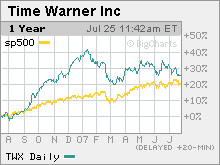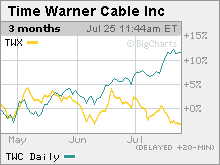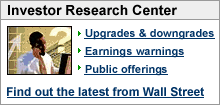Check-up time for AOLIt's been a year since Time Warner revamped AOL to focus on online advertising. Wall Street approves so far but wants more proof the turnaround is for real.NEW YORK (CNNMoney.com) -- A year ago, Time Warner finally relented to market pressure and decided to stop charging broadband customers for its AOL service access fees. Faced with a steadily declining AOL subscriber base, Time Warner made the decision to focus more on the rapidly growing online advertising market and make much of AOL's services free. Since then, the AOL unit has reported three quarters of solid growth in online advertising. And while that has not been enough to offset the lost revenue from subscriber defections - AOL's overall sales have slipped year-over-year for the past several quarters - Wall Street seems pleased with the new direction of AOL.
"Time Warner has resuscitated AOL from the dead," said Diane Jaffee, portfolio manager of the TCW Diversified Value fund, which owns about 1.3 million shares of Time Warner (Charts, Fortune 500) stock. The revival of AOL has been one factor that has helped lift Time Warner's stock over the past year. Since Time Warner announced the decision to make AOL primarily a free, ad-supported service on August 2, 2006, shares have gained 25 percent, outperforming fellow media rivals Walt Disney (Charts, Fortune 500) and News Corp. (Charts, Fortune 500), as well as the broader market. Of course, AOL is not the only thing that drives Time Warner's stock. Time Warner is a media conglomerate that, in addition to being the parent company of CNNMoney.com, owns Time Warner Cable, the second-largest cable firm in the U.S.; the Warner Bros. movie studio; cable networks CNN, HBO and TNT; and the Time Inc. magazine-publishing business. Time Warner reports its second-quarter results on August 1. According to figures from Thomson First Call, Wall Street expects Time Warner to report sales of $11.1 billion; adjusted operating income before depreciation and amortization or OIBDA, an important measure of profitability, of $2.9 billion; and earnings per share of 20 cents. Analysts said the two areas they will be paying the most attention to are AOL and the Time Warner Cable business. "This is going to be a pivotal quarter for AOL. The company needs to report between 30 percent and 40 percent revenue growth on the advertising side in order to offset the decline in subscription growth and add to profits," said Greg Gorbatenko, an analyst with Jackson Securities. AOL reported a 40 percent increase in ad revenues during the first quarter and that helped fuel a 27 percent increase in AOL's OIBDA. But Gorbatenko said he's a little bit concerned about how AOL may have fared during the second quarter, considering that second-quarter results from competitors Yahoo! (Charts, Fortune 500) and Google (Charts, Fortune 500) both disappointed Wall Street. David Joyce, an analyst with Miller Tabak & Co. adds that AOL, which has made several acquisitions lately, including the purchase of behavioral targeting firm Tacoda on Tuesday, could fall further behind some of its rivals who have been making even bigger deals. Aside from Tacoda, AOL has purchased mobile advertising firm Third Screen and German online ad serving company Adtech this year for undisclosed amounts. Those purchases are on top of 2006's acquisitions of online video ad firms Truveo and Lightningcast, also for undisclosed amounts, and the purchase of Advertising.com in 2004 for $435 million. But Joyce said these deals pale in comparison to Google's plan to buy ad placement company DoubleClick for $3.1 billion and Microsoft's (Charts, Fortune 500) move to acquire digital advertising tech firm and online ad agency aQuantive for $6 billion. "AOL is tiptoeing into the online advertising market instead of making big acquisitions and that could possibly be a problem," Joyce said. "While AOL has had some good quarters of advertising revenue growth, if they had made a more substantive acquisition, it could have shown investors that it's confident in the new strategy. AOL has to prove the ad model strategy is working," Joyce added. With this in mind, Joyce said he does not think that Time Warner is looking to sell or spin off AOL anytime soon. Market speculation about an AOL sale or spin-off has been constant for the past year but Joyce said selling AOL now would be a mistake. "I would think Time Warner would want to turn AOL around and get value for its own shareholders instead of selling it," he said. Jaffee agreed, saying that Time Warner should not do anything with AOL just yet. "I'm sure this has been discussed by management. But I think what is holding them back on AOL is that it's not appropriately valued by the market. The company is biding its time," she said. Still, one reason that chatter about AOL's future has increased is because Time Warner already sold a small stake in its Time Warner Cable unit to the public earlier this year. Time Warner Cable (Charts) began trading as a separate stock following the completion of the acquisition of bankrupt cable provider Adelphia. Adelphia's assets were split between Time Warner Cable and Comcast (Charts), the nation's largest cable company. Time Warner is still the majority owner of Time Warner Cable. The cable business accounts for more than a third of Time Warner's sales and more than 40 percent of its adjusted OIBDA. Joyce said Time Warner Cable should report strong results thanks to increases in digital video and Internet telephone subscribers. Analysts expect Time Warner Cable to report sales of $4 billion in the quarter. But Comcast, which reported strong results for the second quarter Thursday morning, surprised Wall Street with a bigger decline in basic video subscribers than expected. That news, combined with an overall brutal day for stocks, caused Comcast's shares to fall more than 5 percent Thursday. This also put pressure on shares of Time Warner and Time Warner Cable, even though Time Warner announced Thursday that it was boosting its quarterly dividend by 13.6 percent. Time Warner's stock fell nearly 2 percent while Time Warner Cable plunged nearly 5.5 percent. Still, Jaffee thinks that Time Warner Cable stands to benefit in the next few quarters as the company integrates the cable systems it inherited from Adelphia. "We have not seen the fruits from the aggregation of Adelphia yet. This is a great opportunity for Time Warner and I'm looking forward to positive impact on the cable business," she said. But that raises an interesting dilemma for some investors. Gorbatenko points out that investors could capitalize on the expected strength in cable by just buying Time Warner Cable instead of Time Warner. That way, he argues, investors would not have to concern themselves with the twists and turns at AOL or how some of Time Warner's slower-growing businesses, such as magazine publishing, the film studios and the cable networks, will fare in the quarter. To that end, it is worth noting that before Thursday's market sell-off, shares of Time Warner Cable and Time Warner have not traded in tandem lately. During the past three months, Time Warner Cable's stock has gained 11 percent while Time Warner has lost 3 percent. Analysts quoted in this story do not own shares of Time Warner and their companies have no investment banking relationships with the company. The reporter of this story owns shares of Time Warner through his company's 401(k) plan. |
Sponsors
|




